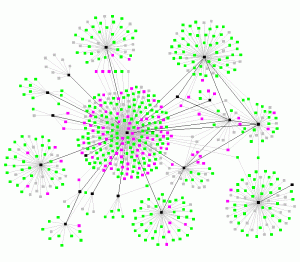Networks and the Ebola Outbreak
The top headline on most, if not all media websites right now is the CDC confirming the first domestically diagnosed case of the highly infectious Ebola virus in the United States. The virus that has been known infamously in areas of Africa has no vaccine developed for it yet, and it has finally reached US soil just as everyone feared in previous weeks. The patient is located in Dallas, TX, where he is being treated and heavily quarantined to try to make sure that the virus doesn’t spread elsewhere. The man had been traveling through Liberia, and when he came back he was quickly isolated due to his symptoms and travel location. Luckily, the virus can only be contracted through direct contact with bodily fluids of an infected person, and the director of the CDC states that he is certain that this outbreak will not spread outside of the Dallas hospital.
I decided to pick this current event for my blog post because not only is this news disconcerting and very prevalent on the web right now, but also because the spread of disease can be effectively represented and analyzed with graph theory. In a visualization of the spread of disease in a network, infected persons would be represented by nodes, and who they were infected by and who they infect would be represented by edges. Since passing the disease is a one way process, the edges would be directed, and so we have a connected digraph. It turns out that this graph doesn’t look so different from a social network taken from a website like Facebook. A network representing the spread of contagions is posted below:
This makes a lot of sense, because if the disease is spread through direct contact and not through the air, like Ebola, the only people who will get infected are the acquaintances, friends, family members, etc. of the infected persons. In this scenario, strong and weak ties will be particularly powerful attributes because someone with a strong tie to an infected person would be much more likely to contract the disease than someone with a weak tie to that person because of higher frequencies of contact. Another property of graphs that is seen prevalently in contagion networks are local bridges. The reason for this is that it only takes one member of a group linked by a local bridge to another group to spread the disease, and this can happen in several different scenarios from social outings to plane travel.
While using networks to predict how the Ebola virus could spread from the only domestic case in the US so far is sure to be disturbing, the information obtained from this patient’s social network can be very useful in stopping the outbreak from spreading any further. It is suspected that the man has had contact with several individuals, including his family and friends, before seeking treatment from the hospital, but I am certain that the CDC is using all of its resources to try to assemble this man’s social network in order to maintain the small size of this outbreak so far.
Link to news article: http://www.cnbc.com/id/102037055#.

